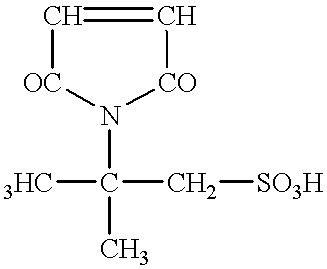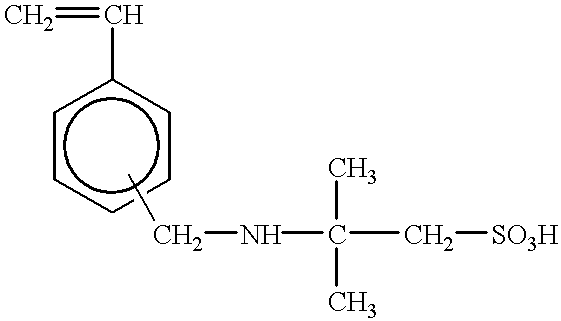It has been generally acknowledged that a toner chargeability is adversely affected if such an ionic or electrically polar substance has not been sufficiently removed therefrom.
However, the removal of such a dispersion stabilizer is generally difficult, and particularly a water-
soluble polymer is difficult to remove because of high
viscosity of its
aqueous solution, thus being liable to remain in a large amount on the
resultant toner particles and adversely affecting the triboelectric chargeability to result in remarkably inferior image qualities.
However, in view of Examples of these proposals, the dispersion stabilizer remaining in the product toner has not been substantially removed, so that problems regarding chargeability and developing performance attributable to the
residual dispersion stabilizer have not been sufficiently solved.
A dispersion stabilizer conventionally used in a wet process for toner production has an advantageous function of uniformly dispersing objective particles but, on the other hand, is accompanied with a difficulty in complete removal thereof, so that a substantial amount thereof remaining on the toner surface can adversely affect the triboelectric chargeability, thus resulting in inferior image forming performances particularly in a high temperature /
high humidity environment.
A residual substance at toner particle surfaces originated from a dispersion stabilizer is the dispersion stabilizer itself, and if the removal thereof is insufficient, the toner surface becomes
moisture-absorptive because of
moisture-absorptivity of the dispersion stabilizer, thus causing a lower chargeability of the toner.
In the case where the dispersion stabilizer element is less than 100 ppm, the
stable state of attraction between the element and the
sulfur-containing
polymer is difficult to achieve, thus lowering the dispersibility of the element in the toner particles, so that the effect of promoting the colorant dispersion in the toner particles is lowered and the charging stability is liable to be lowered.
Further, below 100 ppm, the charge leakage points become fewer so that the toner is liable to be excessively charged triboelectrically in a low
humidity environment.
Further, in order to achieve a dispersion stabilizer element content of below 100 ppm, a complicated washing step is required to result in a lower productivity.
On the other hand, in the case where the dispersion stabilizer element content exceeds 30,000 ppm, the toner is liable to cause a remarkable lowering in chargeability in a
high humidity environment, thus resulting in
fog.
Further, the fixability is remarkably lowered in a low
humidity environment, thus exhibiting inferior fixability in full-
color image formation.
If Tg is below 50.degree. C., the
resultant toner is liable to have lower flowability and storage stability, and also a lower transferability.
If Tg is above 100.degree. C., the resultant toner is liable to exhibit a lower fixability especially in the case of a high
image area.
%, the dispersion stabilizer element is liable to remain in excess, to result in inferior fixability.
In excess of 50 mgKOH / g, the resultant toner particles are liable to have distorted shapes showing a lower circularity and the
release agent exposed at the surface, thus showing a lower developing performance, especially when they are formed through
suspension polymerization.
in. If the content is below 0.01 wt. part, the charge controlling function obtained thereby is scarce, and in excess of 15 wt. parts, the resultant toner particles when produced by
suspension polymerization are liable to have a lower circularity, thus causing lowering in developing performance and transferab
A volatile matter content below 0.01% requires a complicated volatile matter removal treatment, and in excess of 2.0%, the resultant toner is liable to have inferior chargeability in a high temperature /
high humidity environment, particularly after standing for some period.
Below 0.1 g / 10 min., the
dissolution of the polymer in the
monomer becomes difficult, thus resulting in an unstable polymerizable composition and being liable to fail in toner particles having a sharp
particle size distribution.
If MI value exceeds 100 g / 10 min., the polymer has an excessively sharp meltability, thus being liable to result in a toner having inferior anti-blocking property and lower durability.
On the other hand, if Mw exceeds 4000 or Mn exceeds 4000, the
release agent is caused to have an increased
crystallinity and is liable to result in a lower transparency for OHP fixed images.
In excess of the upper limit, the anti-blocking effect is liable to be lowered and the offset-prevention effect is also liable to be adversely affected.
Moreover, several other difficulties are liable to be encountered, such as toner melt-sticking onto the photosensitive drum and the developing sleeve, and also the formation of toner particles having a broader
particle size distribution in the
polymerization process toner production.
A release agent having an SP value below 7.6 shows little
mutual solubility with the polymerizable
monomer or binder resin, thus being liable to cause inferior dispersion in the binder resin which leads to attachment of the release agent and change in chargeability during continuous
image formation on a large number of sheets.
Further, ground
fog and toner concentration change at the time of toner replenishment are also liable to occur.
If a release agent has an SP value above 10.5, the toner particles are liable to cause blocking in a long-term storage.
Further, because of an excessive
mutual solubility with the binder resin, it becomes difficult to form a sufficient release layer between the fixing member and the toner, thus being liable to cause an offset phenomenon.
Further, in the cases of the two-component scheme, the toner is liable to be damaged by a shearing force exerted by the carrier particles, resulting in embedding of the external additive and breakage of the toner particles.
Above 14, the release agent is liable to cause filming on the photosensitive drum surface.
Below 6.times.10.sup.3, the external additive is liable to be embedded, during continuous
image formation, thus being liable to cause a lowering in transferability.
Outside the ranges, similar difficulties as regards the weight-average molecular
weight range are liable to be encountered.
Below 1.2, the resultant toner is liable to have low continuous image forming performance and anti-offset property.
Below 0.1, the toner is liable to have a slower rise-up of charge, thus being liable to cause
fog.
Above 35, the toner is liable to cause a fluctuation in triboelectric chargeability after being left to stand in a high temperature / high
humidity environment.
Further, above 35, the condensation resin is caused to have strong affinity between polymer molecules thereof, so that the
dissolution thereof in the polymerizable monomer becomes difficult, thus taking a longer time for preparation of the polymerizable
monomer composition.
Further, the toner is liable to cause a charge in
image density during continuous image formation.
Above 14.degree. C., the toner is liable to soil the associated members inclusive of the image-bearing member and fail in provide images of good uniformity.
However, in case where the toner size is reduced, the proportion of smaller toner particles is naturally increased, so that it becomes generally difficult to uniformly charge the toner, thus being liable to result in image fog and exhibit a larger attachment force onto the image-bearing member and the developer carrying member.
As a result, the developing performance is liable to be lowered consequently.
A toner having an indefinite shape generally has a lower uniformity of chargeability at convex and concave parts of the toner particles and is caused to have an increased area of contact with the image-bearing member, so that it is liable to results in an increased amount of transfer residual toner.
At a pH below 4.5, a portion of the dispersion stabilizer can be dissolved to lower the dispersion stabilizing effect, thus being liable to fail in droplet dispersion in some cases.
At a pH above 13.0, some component in the monomer composition can be decomposed, thus failing to exhibit a sufficient chargeability in some cases.
On the other hand, below 30 3 emu / cm.sup.3, carrier attachment is liable to occur due to insufficient constraint force acting on the carrier particles.
If the gap is narrower than 100 .mu.m, the supply of the developer is liable to be insufficient to result in a low
image density.
In excess of 1000 .mu.m, the lines of magnetic force exerted by a developing pole S1 is spread to provide a
low density of magnetic
brush, thus being liable to result in an inferior dot reproducibility and a weak carrier constraint force leading to carrier attachment.
If the application
voltage is below 500 volts it may be difficult to obtain a sufficient image density and fog toner on a non-image region cannot be satisfactorily recovered in some cases.
Above 5000 volts, the
latent image can be disturbed by the magnetic
brush to cause lower image qualities in some cases.
The frequency can affect the process, and a frequency below 500 Hz may result in
charge injection to the carrier, which leads to lower image qualities due to carrier attachment and latent image disturbance, in some cases.
Above 10000 Hz, it is difficult for the toner to follow the
electric field, thus being liable to cause lower image qualities.
If the developing nip C is narrower than 3 mm, it may be difficult to satisfy a sufficient image density and a good dot reproducibility.
If broader than 8 mm, the developer is apt to be packed to stop the movement of the apparatus, and it may become difficult to sufficiently prevent the carrier attachment.
In this
system, a stress is applied to the toner, thus being liable to cause increased toner agglomeration due to toner deterioration and toner melt-sticking onto the developing sleeve 84 and / or the toner application roller 82.
 Login to View More
Login to View More 


